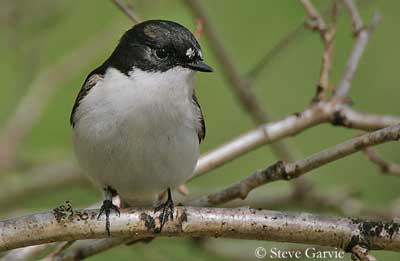
European Pied Flycatcher
Ficedula hypoleuca
Passeriforme Order – Muscicapidae Family
BIOMETRICS:
Length: 13 cm
Wingspan: 22 cm
Weight: 9,7-22 g
DESCRIPTION:
The European Pied Flycatcher belongs to the Old World flycatchers. This species is migratory, breeding in most parts of Europe and wintering in W Africa.
Adult male in breeding plumage is black and white.
Upperparts are glossy black, but according to the range, they can be dark brown to grey-brown. Flight feathers are blackish-brown with large wing patch. Tail is blackish with white outermost pair of rectrices.
Underparts are white, including chin, neck sides and throat. Underwing shows creamy axillaries and grey-brown coverts.
Head is black with small white patch on forehead. But this criterion can be absent or divided in two smaller patches.
The bill is blackish. Eyes are dark brown. Legs and feet are black.
Fr: Gobemouche noir
All : Trauerschnäpper
Esp: Papamoscas Cerrojillo
Ital: Balia nera
Nd: Bonte Vliegenvanger
Sd: Svartvit flugsnappare
Photographers :
Steve Garvie
RAINBIRDER Photo galleries
Nicole Bouglouan
PHOTOGRAPHIC RAMBLE
Text by Nicole Bouglouan
Sources :
HANDBOOK OF THE BIRDS OF THE WORLD Vol 11 by Josep del Hoyo, Andrew Elliott and David Christie - Lynx Edicions - ISBN: 849655306X
THE HANDBOOK OF BIRD IDENTIFICATION FOR EUROPE AND THE WESTERN PALEARCTIC by Mark Beaman, Steve Madge - C.Helm - ISBN: 0713639601
ENCYCLOPEDIE DES OISEAUX DE FRANCE ET D’EUROPE – de Peter Hayman et Rob Hume - Flammarion – ISBN : 2082009920
THE COMPLETE BOOK OF BRITISH BIRDS – Written by “Royal Society for the Protection of Birds” experts - Préface de Magnus Magnusson - Michael Cady- Rob Hume Editors - ISBN: 0749509112
BirdLife International (BirdLife International)
Wikipedia (Wikipedia, The Free Encyclopedia)

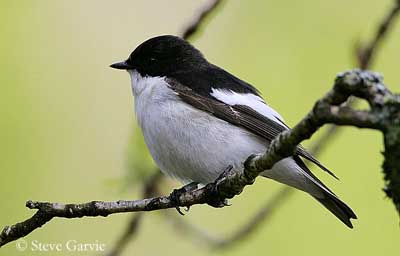
Male in non-breeding plumage has brown upperparts with black uppertail coverts. Forehead and crown are brown. The wing bar is narrower, and the plumage is browner and duller, with throat, breast and flanks tinged buff.
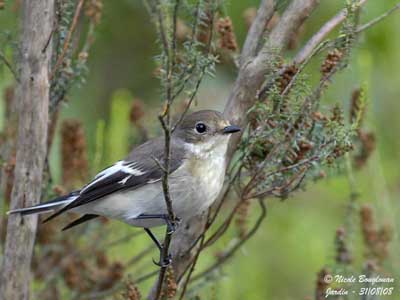
Female in breeding plumage is similar to non-breeding male with less conspicuous wing markings. Upperparts are brown. Forehead can be slightly creamy, and uppertail coverts are dark to blackish. Tail is dark brown with whitish areas. Underparts are whitish with pale brown wash on breast and flanks.
In non-breeding plumage, female is similar with browner forehead and buffish underparts.
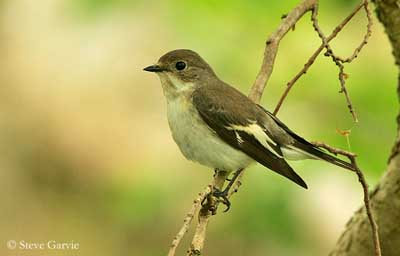
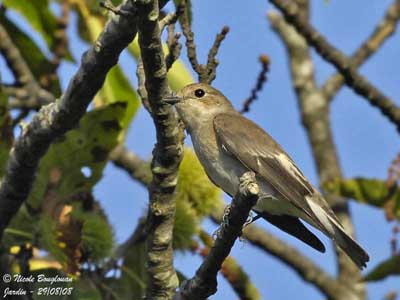
Juvenile has dark brown upperparts with pale buff spots, and buffish-white underparts with black-tipped feathers.
First winter male and female resemble adult female with broad white wing bar.
We find 4 subspecies:
F.h.hypoleuca breeds in W, N and C Europe, and winters in W and WC Africa.
F.h. sibirica breeds in W and C Siberia, and winters in W and WC Africa.
F.h. iberiae breeds in Spain and winters in W Africa.
F.h. speculigera breeds in NW Africa and winters in W Africa, mainly in N Senegal and Ivory Coast.
Races differ in colours of upperparts, from grey-brown to blackish, and with more or less extended white areas on wings and forehead.
VOICE: SOUNDS BY XENO-CANTO
The European Pied Flycatcher’s typical call is a loud “ouiit” and a short “ouet” or “tee”, often combined “ouii-tec” and uttered together when the bird is alarmed.
Both mates utter soft “tsrr” between them.
The song is a series of sweet, warbled phrases alternating in pitch and ending abruptly in trill “tre tre tre, trep trep, tchetche-tchouii”.
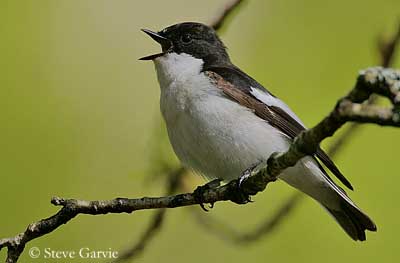
HABITAT:
The European Pied Flycatcher frequents forest habitats during the breeding season. It needs well wooded areas providing suitable cavity-nests. It favours the deciduous forests because they offer more natural cavities.
In Europe, it frequents sunny, open mature deciduous and mixed forests, but also orchards, urban areas and occasionally gardens.
The breeding populations of N Africa breed in wooded areas between 1200 and 1800 metres of elevation.
On their wintering areas, they can be seen at lowland forest edges, gallery forest, savannahs, woodlands, gardens, cultivated areas with large trees, wooded mountain slopes up to 2000 metres in Liberia.
During migrations, they can be seen in dry, bushy areas.
RANGE:
The European Pied Flycatcher breeds in large parts of Europe and Western Asia, and winters in Western Africa.
(See above for more details about the subspecies’ range)
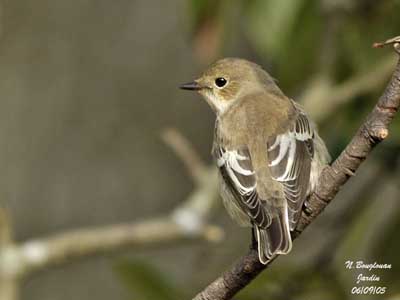
BEHAVIOUR:
The European Pied Flycatcher feeds mainly on insects caught from a perch. The bird hovers and captures the prey in flight or on the ground after a light dive. During the nesting period, it favours the caterpillars to feed the young.
It gleans among leaves, but also on tree-trunks and branches, and on the ground where it takes non-flying preys such as caterpillars and some earthworms. It also consumes snails and may occasionally hammer them on hard surface to break open the shell, as the Song Thrush.
It also takes some plant matter such as fruit and berries, and seeds. It picks berries from the bushes while hovering.
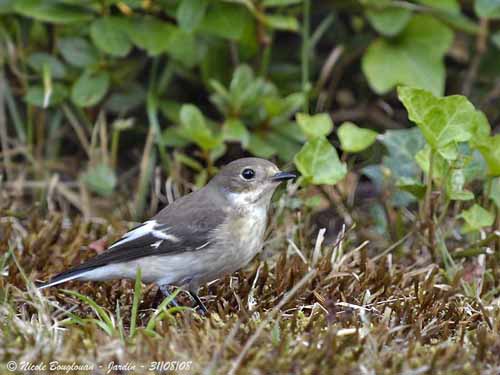
During the breeding season, the European Pied Flycatcher defends a small territory near the nesting cavity. The male is often polyterritorial with a female already laying, while it establishes a second territory and tries to attract another female.
Usually, this species is monogamous, but the polygyny may be higher in some regions with low breeding density. It is solitary nester and territorial.
The small territory is used for pair formation and restricted to about 20 metres around the nest-site.
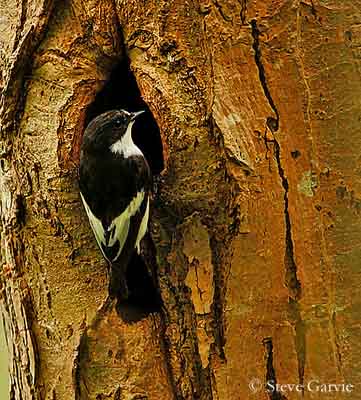
When the male is polygynous, it takes part in nesting duties for the first brood, whereas other females raise their chicks alone, except when the brood is adopted by another male.
This type of breeding behaviour involves higher reproductive success.
The male displays at the nest hole with the head out of the cavity in order to expose the white patches of the forehead. Displays outside the hole show the male with fanned tail to enhance the white outer tail feathers.
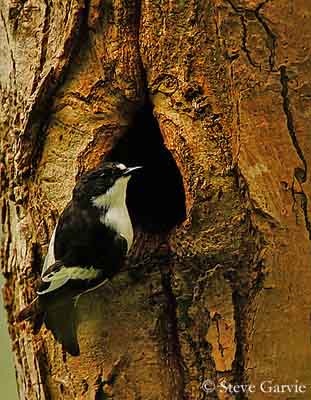
The European Pied Flycatcher is migratory and winters in W and WC Africa. It is a nocturnal long-distance migrant. When they return to their breeding areas, males often arrive before females.
FLIGHT:
The European Pied Flycatcher has agile flight, hovering at bushes for picking berries and performing sallies to catch insects. As all the migratory birds, it has long, rather rounded wings.
REPRODUCTION:
Breeding season occurs from late April to late June in Europe.
This species usually produces a single brood.
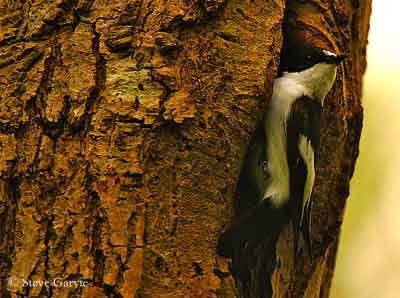
Usually, the older male selects several sites and then, pairs with several females.
Displays occur at hole and if most of them are monogamous, several birds are polygynous. In this case, nests are about 200 metres apart from each other.
The male utters short rattle calls when a female approaches the site. It also performs wing and tail flicking and finally chases the female.
Then, after a song flight, the male flies to several holes while singing loudly, and enters each hole with other song flight.
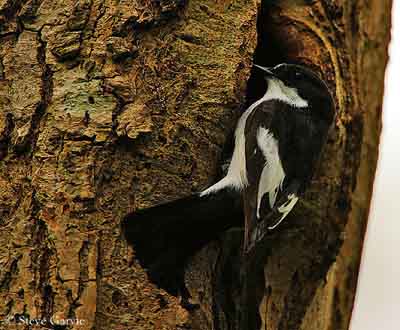
The female watches these displays from the canopy, and finally follows the male into a hole, but if she leaves the hole first, she does not accept the male. The final choice of the nest-site is by female.
After pair formation, courtship feeding by male is observed and used to maintain the pair-bonds.
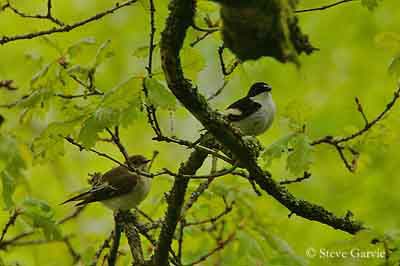
The nest is built by female in some days. It is a loose cup made with dead leaves, moss and stems. The interior is lined with softer materials such as rootlets, fine grasses, hair and feathers. It is placed about 2 to 10 metres above the ground, in cavity in tree, wall, building, or in nest-box.
Female lays 4-10 eggs at one day intervals. She incubates alone during 13-15 days. Chicks are usually fed by both parents, and fledge about 14-18 days after hatching. They leave the parental territory within a day, but parents feed them for one week more.
If the clutch is destroyed, the female lays a second brood.
The European Pied Flycatcher sometimes hybridizes with the Collared Flycatcher (Ficedula albicollis) when territories overlap.
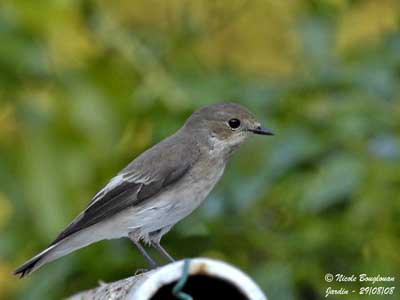
DIET:
The European Pied Flycatcher feeds primarily on various insects, both flying and terrestrial, such as flies, beetles, adult and larval lepidopterans, mayflies, dragonflies and damselflies, grasshoppers, bugs, cockroaches and also spiders, small molluscs and earthworms, berries, fruit and seeds.
It performs short sallies to catch insects in flight, hovers to pick berries from vegetation, and hunts also on the ground.
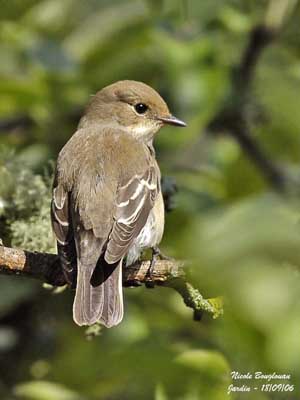
PROTECTION/THREATS/ STATUS:
The European Pied Flycatcher has stable populations and this bird is common in most parts of the range.
Nest-boxes increase the density when natural cavities are lacking. Increases are often observed, more than declines or stability.
This species is not threatened at this moment.